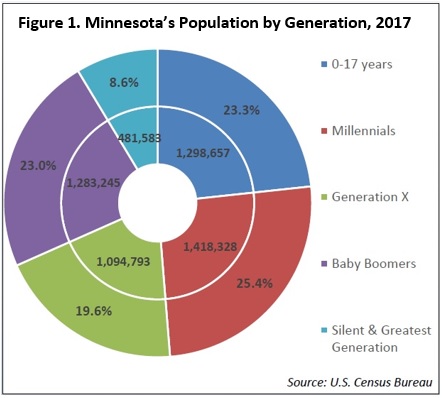 Southwest Minnesota is a national leader in agricultural production, and renewable energy.
Southwest Minnesota is a national leader in agricultural production, and renewable energy.
The region's thriving manufacturing sector includes food processing, machinery, printing, metal products, and computers and electronic products.
Want the freshest data delivered by email? Subscribe to our regional newsletters.
3/5/2019 1:00:00 PM
Luke Greiner
With just over 1.4 million people, millennials are the largest generation in the state’s population, just ahead of Generation Z (1.3 million), baby boomers (1.3 million people), and Generation X (1.1 million). In sheer numbers, the two youngest generations are the largest, while the two oldest generations – the Silent Generation and the Greatest Generation – are the smallest (Figure 1).

In the past, getting a good grasp of the population broken down by generation is difficult because Census data primarily rely on 5-year age cohorts, which don’t always line up perfectly with generational boundaries. According to the Bureau of Labor Statistics, generations in the U.S. are defined by the birth years:
| Birth Years | Generational Title | Age in 2017 |
|---|---|---|
| 1927 or earlier | Greatest Generation | 90 years & over |
| 1928 to 1945 | Silent Generation | 72 to 89 years old |
| 1946 to 1964 | Baby Boomers | 53 to 71 years old |
| 1965 to 1980 | Generation X | 37 to 52 years old |
| 1981 to 1999 | Millennials | 18 to 36 years old |
| 2000 to 2017 | "Generation Z"? | 0 to 17 years old |
While millennials were also the largest generation in Southwest Minnesota, the generation gap was much smaller. In fact, baby boomers were still the second largest generation in the region, just ahead of Generation Z, and nearly 21,500 people larger than Generation X, which comprised approximately 17.8 percent of the Southwest population.
Using data from the Census Bureau’s Population Estimates program, DEED created an interactive visualization that provides insight into the estimated size of the generations in each region and county of the state for 2017. This tool can help local elected officials and workforce development professionals understand the demographic shifts occurring in their geography.
For example, 15 of the 23 counties in Southwest Minnesota actually have larger baby boom cohorts than millennials. Instead, just four counties had larger millennial populations, with the huge college-aged population in the Mankato/North Mankato metro area essentially overwhelming the smaller millennial cohorts in the other counties in the region. Perhaps surprisingly, four counties in the region also had larger Generation Z populations (Table 1).
Contact Luke Greiner at 320-308-5378 or Mark Schultz.